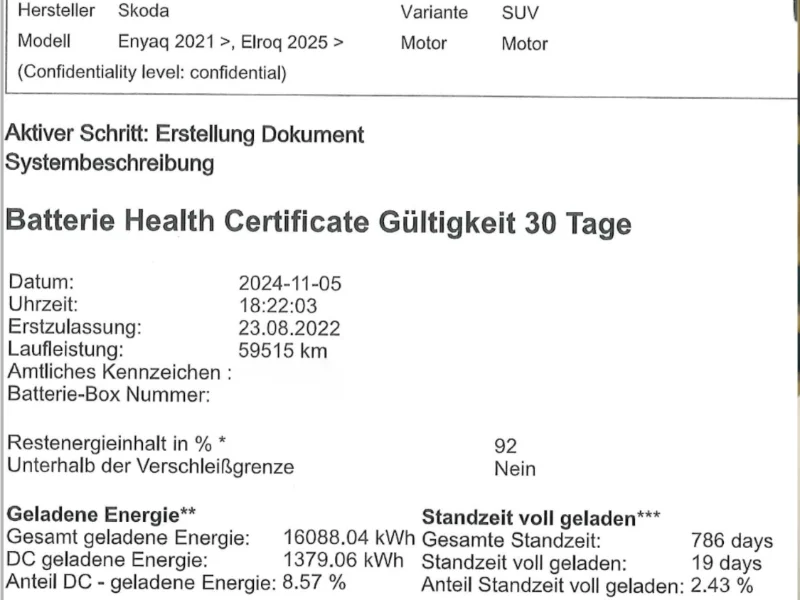The battery in an electric car is what the engine was in a combustion engine car: the most expensive and crucial component. When buying a used Škoda ENYAQ, it should therefore be given special attention. There are three things to consider: the technical condition, the charging capacity and the vehicle’s equipment in terms of battery temperature control and certificates.
Note: This article only applies to first-generation ENYAQ iVs from 11/2020 to 10/2023. With the second generation from 10/2023 onwards, charging performance and charging times in particular have changed significantly, and preheating is also available from this point onwards!
Battery condition and degradation
Lithium-ion batteries age over time due to both use (charging cycles) and storage. This ageing is called degradation. It reduces the usable capacity and thus the range.
The so-called State of Health (SoH) – i.e. the battery health in percent – is used for evaluation. 100% represents new condition. This value decreases over years of use, also depending on mileage, as this is accompanied by corresponding charging cycles.
| SoH-Value | Condition | Recommendation |
|---|---|---|
| 95 – 100 % | very good | Practically as new |
| 90 – 95 % | good | Normal wear and tear |
| 85 – 90 % | acceptable | Price reduction advisable |
| < 85 % | poor | Better to keep looking |
Škoda provides an 8-year or 160,000 km warranty on the high-voltage battery up to a SoH of 70%. In practical terms, this means that a battery with 70% remaining capacity is still functional, but its usability is significantly limited. For driving a vehicle, 80% SoH is more likely to be the lower limit for meaningful use.
Battery certificates
When buying a used car, there should always be a certificate documenting the SoH. Skoda’s own certificate is ideal, but a certificate from a third-party provider is also valuable. Never buy an ENYAQ without a battery certificate! Check the VIN to see if the certificate belongs to the car.
- Škoda Batteriezertifikat
Issued by the workshop, it contains the following information in addition to the SoH:- Ratio of DC to AC charges
- Standing times at 100%
- Battery ID and serial number
- This certificate is considered official proof of warranty and condition.
- Third-party certificates (e.g. AVILOO and others)
- These usually only show the SoH and are based on their own measurement methods.
- Advantage: Also possible outside the dealer network.
- Disadvantage: Not fully compatible with internal Škoda data.

Example of 100% SoH

Example of 92%, Skoda original certificate
Charging capacity, DC and AC
The ENYAQ can be charged in two ways: AC (alternating current) and DC (direct current).
AC charging usually takes place at home using a wall box, while DC charging takes place at fast charging stations.
AC charging (alternating current)
Model 50: up to 7.2 kW (2-phase)
Models 60, 80, 80x, RS: up to 11 kW (3-phase)
AC charging is carried out at a constant power, i.e. without a charging curve or power drop during charging.
DC charging (fast charging)
The DC charging power has been changed several times over the model years. Early vehicles had only 50 kW as standard, and higher, so-called extended power was available as an option at an additional cost. From model year 2022 onwards, extended charging power became standard
| Model | Standard DC power (until 06/21 at extra cost) | increased to with software update 3.0 | 10–80% charging time with software 3.0 |
|---|---|---|---|
| ENYAQ iV 50 | 100 kW | 100 kW | ca. 35 mins |
| ENYAQ iV 60 | 100 kW | 120 kW | ca. 35 mins |
| ENYAQ iV 80 | 125 kW | 135 kW | ca. 29 mins |
| ENYAQ iV 80x / RS | 125 kW | 175 kW | ca. 35 mins |
For used vehicles, it is crucial to know whether the extended charging capacity has been activated.
If it has not, this can be a good bargaining point.
Preheating – the issue of battery temperature control
First-generation ENYAQ models (software 3.x) do not feature active battery preheating prior to fast charging. This means that if the battery is cold, the charging speed drops noticeably in winter.
It is currently unclear whether this function will be added via an update.
Practical tip: Anyone who frequently drives long distances and regularly uses fast chargers in winter should take this into account. For users who mainly drive short distances or charge at home using a wall box, this is hardly relevant. There are ways to warm up the battery through driving style. However, this is not advisable and should never lead to traffic hazards.
Heat pump – efficiency in winter
The heat pump is optional on the ENYAQ (in certain markets it was or is standard). It uses ambient heat to heat the interior in an energy-efficient manner. In practice, it provides a 5–10% range advantage in winter, less on short journeys. Its usefulness depends heavily on the climate and driving style – it is useful, but not a must-have.
Conclusion
A healthy battery with documented SoH, up-to-date software and activated fast charging capability is the key to a good used ENYAQ. When buying, pay particular attention to the charging capacity, the certificates and, if you drive long distances a lot, the presence of a heat pump. Then you will get a vehicle that remains technically sound and efficient in everyday use.
